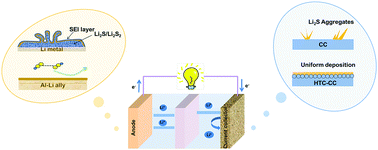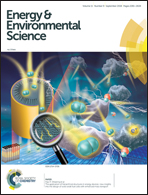Towards a reliable Li-metal-free LiNO3-free Li-ion polysulphide full cell via parallel interface engineering†
Abstract
There has been intensive concentration and effort on addressing the notorious challenges of Li–S batteries with respect to polysulphide utilization and lithium dendrite inhibition. However, the search for and optimisation of a Li-metal-free full cell design remain relatively premature in terms of the generic synchronous approach to improve the anode/cathode stability while balancing the anode/cathode capacity. We hereby report a parallel interface engineering (PIE) strategy to enhance the full-cell performance of the Li-ion polysulphide battery. Very importantly, this PIE strategy allows the use of a Li-metal-free anode and a LiNO3-free electrolyte. The cell-level improvement is attributable to more efficient and uniform lithium sulphide deposition on the chemically uniform surfaces of the carbon cathode and suppressed growth of dendritic species on the Li–Al alloy anode with an implantable solid–electrolyte interphase. Quantitative electrochemical alloying for anode fabrication allows increased lithium utilization relative to the total anode capacity. The PIE strategy represents a facile approach to address the troublesome issues of Li–S batteries at the full cell level.



 Please wait while we load your content...
Please wait while we load your content...